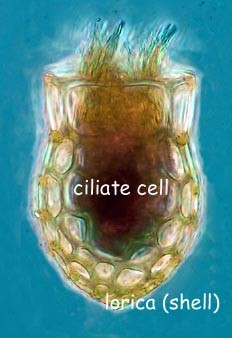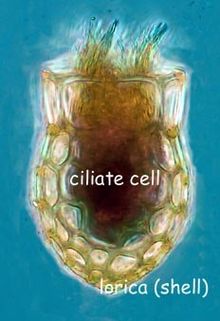丁丁虫亚目
来自维基百科,自由的百科全书
砂壳纤毛虫(學名:Tintinnina),又名有鐘纖毛虫或丁丁虫,泛指隶属于纤毛虫门旋毛纲之下丁丁虫亚目的物種。丁丁虫亚目舊屬旋毛纲,現時被重新分類,成為了寡毛纲Choreotrichida目之下的五個亞目之一[1]。本分類單元包括有种数在1000种左右,大多数在海洋中营浮游生活,属微型浮游动物(microzooplankton),主要摄食浮游硅藻和鞭毛虫,是水体微食物环的重要组成部分,在水体中的能量流动和物质循环中占重要地位[2]。
沒有或很少條目链入本條目。 (2012年2月15日) |
砂壳纤毛虫的虫体生活在壳中,其外殼是其獨特的標誌。有部分文獻依從日語文獻,稱呼這種外殼為胴甲(Lorica)[3]。 这些外壳大多呈壶形、花瓶形或管形,主要由蛋白質及小量礦物質構成[3],都有一个开口,有的在反口面还有一个较小的开口,虫体有一个柄固着在壳的后端,通过身体的伸缩可以将身体伸出和缩进壳内;在环境不利时,虫体会离开壳[4]。
化石紀錄
形狀和大小類似於丁丁虫的胴甲的化石,被稱為Calpionellids(長約50到200微米[5],已于中生代灭绝[6]),最早出現在奧陶紀,但由方解石形成,並且由於沒有已知的丁丁蟲會生成含方解石成份的纖毛狀外殼,因此它們不太可能是丁丁虫的化石——甚至可能根本與纖毛蟲完全無關[7][8]。能夠與現生丁丁蟲相關連的化石記錄(例如:黏着在一起的胴甲化石)出現於侏罗纪時期,但數量並不多,直到白垩纪才開始大量出現[9]。 xTintinnids are an important part of the fossil record because of the rarity with which most other ciliates become preserved under the conditions of the marine environment. The loricae of some tintinnids are easily preserved, giving them a relatively good fossil record.

形態描述

不同种的砂壳纤毛虫的壳或胴甲的长度和口径变化很大。壳长最大的记录是巨拟网纹虫(Parafavella gigantea)壳为750 μm(Marshall, 1969),最小的壳为极小领细壳虫(Stenosemella perpusilla),壳长13 μm(Hada, 1970)。同一个种中,不同海域不同个体间的长度差可达300 μm。例如,巨拟网纹虫的最大记录750 μm (Marshall, 1969),但是大多为337-576 μm(Campbell, 1942)。同一种中不同个体壳的大小可能是年龄的标志,小壳是幼体,大壳则是成熟的个体(Gold and Morales, 1976b)。
They were among the many planktonic microorganisms featured in Ernst's 恩斯特·海克尔's classic work popularizing the beauty of the natural world "Art forms in Nature" (自然界的藝術形態).
如同其他原生生物,砂壳纤毛虫屬於一種複雜的單細胞真核生物。牠們是丁丁是異養水生生物(heterotrophic aquatic organisms), 以能進行光合作用的藻類和细菌為食[10],均為 體長介乎20到200微米的微型浮游生物。Tintinnids are found in marine and freshwaters. However, they are most common in salt water and are usually present in concentrations of about 100 a liter but can reach abundances of several thousand per 公升.[11] Characteristics of their lorica, or shells, are classically used to distinguish the roughly 1000 species described. However, in recent years application of histological and molecular techniques have led to many taxonomic revisions.[12]
Many species appear to have wide distributions (for example from the 切萨皮克湾 to 新喀里多尼亞) while others are restricted to certain areas, such as arctic waters or coastal seas.[13] Nonetheless, in any given locale dozens of species can be found. Like other members of the microzooplankton (such as oligotrich ciliates, heterotrophic 双鞭毛虫门s, radiolarians, etc.), tintinnids are a vital link in aquatic food chains as they are the '食草动物s' of the plankton. They feed on 浮游植物 (algae and cyanobacteria) and in turn act as food for larger organisms such as 橈腳類s (small 甲殼亞門s) and larval fish.[14]
The color image on the right is a specimen of Dictyocysta mitra from the Bay of 滨海自由城 in the Mediterranean Sea. The hair-like projections pointing out of the top of the shell are the cilia of the cell. The cilia generate a water flow across the mouth of the cell, bringing food into contact and move the tintinnid. Their swimming pattern is rather 'jumpy'- or dancing- they are part of the 'choreotrichs' which means dancing hairs from their swimming behaviour and cilia.[10]
分類
- Family Ascampbelliellidae Corliss, 1960
- Family Codonellidae Kent, 1881
- Family Codonellopsidae Kofoid & Campbell, 1929
- Family Cyttarocylididae Kofoid & Campbell, 1939
- Family Dictyocystidae Haeckel, 1873
- Family Epiplocylididae Kofoid & Campbell, 1939
- Family Metacylididae Kofoid & Campbell, 1929
- Family Nolaclusiliidae Sniezek, Capriulo, Small & Russo, 1991
- Family Petalotrichidae Kofoid & Campbell, 1929
- Family Ptychocylididae Kofoid & Campbell, 1929
- Family Rhabdonellidae Kofoid & Campbell, 1929
- Family Tintinnida incertae sedis
- Family Tintinnidae Claparède & Lachmann, 1858
- Family Tintinnidiidae Kofoid & Campbell, 1929
- Family Undellidae Kofoid & Campbell, 1929
- Family Undellidae incertae sedis
- Family Xystonellidae Kofoid & Campbell, 1929
- 異名:
- Coxliellidae Kofoid & Campbell, 1929[15]被認為是Metacylididae Kofoid & Campbell, 1929的異名,因為其其模式屬Coxliella被認為是nomen inquirendum[1],即「尚在研究是否合適的命名」[16]。
圖庫
-
Life history stages of a tintinnid, Eutintinnus inquilinus. In ciliates reproduction (B&C) is divorced from sexual recombination (D&E).
-
Tintinnids of the California Current Ecosystem
-
Amundsen Sea (Antarctica) Tintinnids
-
Images of tintinnids and other microplankton found in the Chukchi Sea in the Arctic
-
Tintinnids of the Thau Lagoon (Sète, France)
-
Tintinnids from the estuarine region of the Ganges River in India
參考文獻
外部連結
Wikiwand - on
Seamless Wikipedia browsing. On steroids.








